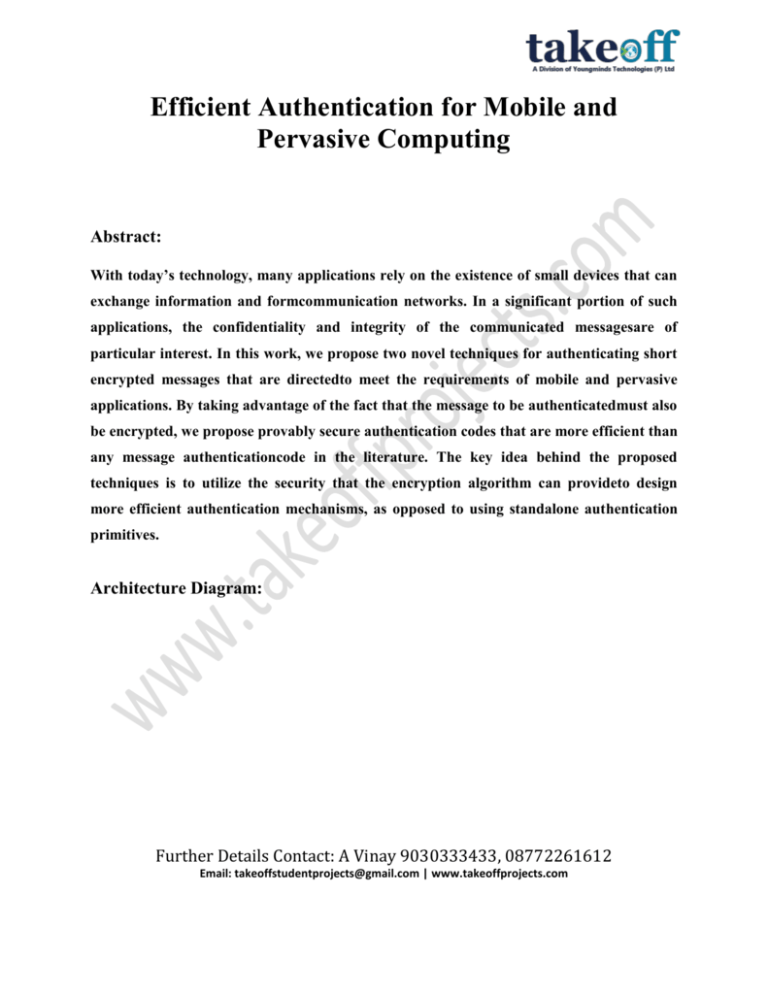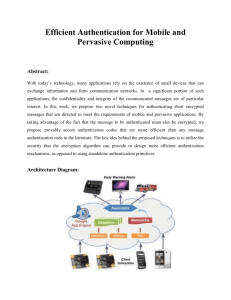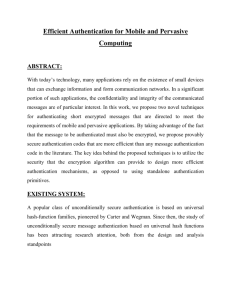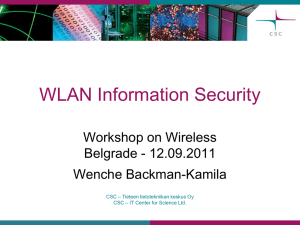authenticating short encrypted messages
advertisement

Efficient Authentication for Mobile and Pervasive Computing Abstract: With today’s technology, many applications rely on the existence of small devices that can exchange information and formcommunication networks. In a significant portion of such applications, the confidentiality and integrity of the communicated messagesare of particular interest. In this work, we propose two novel techniques for authenticating short encrypted messages that are directedto meet the requirements of mobile and pervasive applications. By taking advantage of the fact that the message to be authenticatedmust also be encrypted, we propose provably secure authentication codes that are more efficient than any message authenticationcode in the literature. The key idea behind the proposed techniques is to utilize the security that the encryption algorithm can provideto design more efficient authentication mechanisms, as opposed to using standalone authentication primitives. Architecture Diagram: Further Details Contact: A Vinay 9030333433, 08772261612 Email: takeoffstudentprojects@gmail.com | www.takeoffprojects.com Existing System: There are two important observations to make about existing MAC algorithms. First, they are designed independently of any other operations required to be performed on the message to be authenticated. For instance, if the authenticated message must also be encrypted, existing MACs are not designed toutilize the functionality that can be provided by the underlying encryption algorithm. Second, most existing MACs are designed for the general computer communication systems, independently of the properties that messages can possess. For example, one can find that most existing MACs are inefficientwhen the messages to be authenticated are short. (For instance, UMAC, the fastest reported message authentication code in the cryptographic literature, has undergone large algorithmic changes to increase its speed on short messages ). Further Details Contact: A Vinay 9030333433, 08772261612 Email: takeoffstudentprojects@gmail.com | www.takeoffprojects.com Disadvantages: 1.Existing MACs are not designed toutilize the functionality that can be provided by the underlying encryption algorithm. 2.Most existing MACs are designed for the general computer communication systems, independently of the properties that messages can possess. Proposed System: We propose the followingresearch question: if there is an application in which messagesthat need to be exchanged are short and both their privacyand integrity need to be preserved, can one do better thansimply encrypting the messages using an encryption algorithmand authenticating them using standard MAC algorithm? Weanswer the question by proposing two new techniques forauthenticating short encrypted messages that are more efficientthan existing approaches. In the first technique, we utilize thefact that the message to be authenticated is also encrypted,with any secure encryption algorithm, to append a short randomstring to be used in the authentication process. Advantages: 1.More security,using two concepts one is mobile computing and another one is pervasive computing. 2.Therandom strings used for different operations are independent,the authentication algorithm can benefit from the simplicityof unconditional secure authentication to allow for faster andmore efficient authentication, without the difficulty to manageone-time keys. In the second technique, we make the extraassumption that the used encryption algorithm is block cipherbased to further improve the computational efficiency of thefirst technique. Implementation modules: Further Details Contact: A Vinay 9030333433, 08772261612 Email: takeoffstudentprojects@gmail.com | www.takeoffprojects.com 1. 2. 3. 4. Authenticating Short Encrypted Messages Security Model Data Privacy Security of the Authenticated Encryption Composition AUTHENTICATING SHORT ENCRYPTED MESSAGES: In this module, we describe our first authentication scheme thatcan be used with any INDCPA secure encryption algorithm.An important assumption we make is that messages to beauthenticated are no longer than a predefined length. Thisincludes applications in which messages are of fixed lengththat is known a priori, such as RFID systems in which tagsneed to authenticate their identifiers, sensor nodes reportingevents that belong to certain domain or measurements withina certain range, etc. The novelty of the proposed scheme isto utilize the encryption algorithm to deliver a random stringand use it to reach the simplicity and efficiency of one-timepad authentication without the need to manage impracticallylong keys. Security Model: A message authentication scheme consists of a signing algorithmS and a verifying algorithm V. The signing algorithmmight be probabilistic, while the verifying one is usually not.Associated with the scheme are parameters and N describingthe length of the shared key and the resulting authenticationtag, respectively. On input an `-bit key k and a message m,algorithm S outputs an N-bit string called the authentication tag, or the MAC of m. On input an `-bit key k, a messagem, and an N-bit tag , algorithm V outputs a bit, with 1standing for accept and 0 for reject. We ask for a basicvalidity condition, namely that authentic tags are accepted withprobability one.) for a random but hidden choice of k. A can query Sto generate a tag for a plaintext of its choice and ask the verifierV to verify that _ Further Details Contact: A Vinay 9030333433, 08772261612 Email: takeoffstudentprojects@gmail.com | www.takeoffprojects.com is a valid tag for the plaintext. Formally, A’sattack on the scheme is described by the following experiment: 1) A random string of length ` is selected as the sharedsecret. 2) Suppose A makes a signing query on a message m. Thenthe oracle computes an authentication tag _ = S(k;m)and returns it to A. (Since S may be probabilistic, thisstep requires making the necessary underlying choice ofa random string for S, anew for each signing query.) 3) Suppose A makes a verify query (m; _ ). The oraclecomputes the decision d = V(k; m; _ ) and returns itto A. Security of the Authenticated Encryption Composition: In this module, it defined two notions of integrity for authenticated encryption systems: the first isintegrity of plaintext (INT-PTXT) and the second is integrity of ciphertext (INTCTXT). Combined with encryption algorithmsthat provide in-distinguish ability under chosen plaintext attacks(IND-CPA), the security of different methods for constructinggeneric compositions is analyzed. Note that our constructionis an instance of the Encrypt-and-Authenticate (E&A) genericcomposition since the plaintext message goes to the encryptionalgorithm as an input, and the same plaintext message goes tothe authentication algorithm as an input. Data Privacy: Further Details Contact: A Vinay 9030333433, 08772261612 Email: takeoffstudentprojects@gmail.com | www.takeoffprojects.com Recall that two pieces of information are transmitted to the intended receiver (the ciphertext and the authentication tag),both of which are functions of the private plaintext message.Now, when it comes to the authentication tag, observe that thenonce r serves as a one-time key (similar to the role r playsin the construction of Section . The formal analysis that theauthentication tag does not compromise message privacy isthe same as the one provided .The ciphertext of equation ,on the other hand, is astandard CBC encryption and its security is well-studied; thus,we give the theorem statement below without a formal proof (interested readers may refer to textbooks in cryptography. System Configuration:H/W System Configuration:- Processor - Pentium –III Speed - 1.1 Ghz RAM - 256 MB(min) Hard Disk - 20 GB Floppy Drive - 1.44 MB Key Board - Standard Windows Keyboard Mouse - Two or Three Button Mouse Further Details Contact: A Vinay 9030333433, 08772261612 Email: takeoffstudentprojects@gmail.com | www.takeoffprojects.com Monitor - SVGA S/W System Configuration: Operating System :Windows95/98/2000/XP Front End : java, jdk1.6 Database : My sqlserver 2005 Database Connectivity : JDBC. Further Details Contact: A Vinay 9030333433, 08772261612 Email: takeoffstudentprojects@gmail.com | www.takeoffprojects.com








